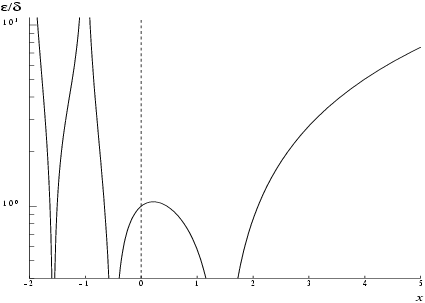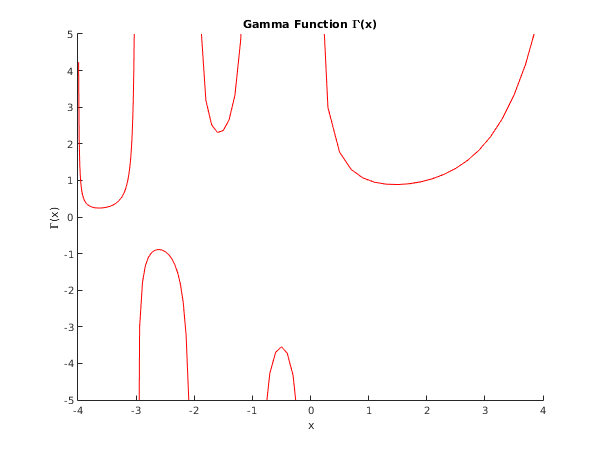PDF version (NAG web site
, 64-bit version, 64-bit version)
NAG Toolbox: nag_specfun_gamma (s14aa)
Purpose
nag_specfun_gamma (s14aa) returns the value of the gamma function , via the function name.
Syntax
Description
nag_specfun_gamma (s14aa) evaluates an approximation to the gamma function
. The function is based on the Chebyshev expansion:
and uses the property
. If
where
is integral and
then it follows that:
- for , ,
- for , ,
- for , .
There are four possible failures for this function:
| (i) |
if is too large, there is a danger of overflow since could become too large to be represented in the machine; |
| (ii) |
if is too large and negative, there is a danger of underflow; |
| (iii) |
if is equal to a negative integer, would overflow since it has poles at such points; |
| (iv) |
if is too near zero, there is again the danger of overflow on some machines. For small , , and on some machines there exists a range of nonzero but small values of for which is larger than the greatest representable value. |
References
Abramowitz M and Stegun I A (1972) Handbook of Mathematical Functions (3rd Edition) Dover Publications
Parameters
Compulsory Input Parameters
- 1:
– double scalar
-
The argument of the function.
Constraint:
must not be zero or a negative integer.
Optional Input Parameters
None.
Output Parameters
- 1:
– double scalar
The result of the function.
- 2:
– int64int32nag_int scalar
unless the function detects an error (see
Error Indicators and Warnings).
Error Indicators and Warnings
Errors or warnings detected by the function:
Cases prefixed with W are classified as warnings and
do not generate an error of type NAG:error_n. See nag_issue_warnings.
-
-
The argument is too large. On soft failure the function returns the approximate value of at the nearest valid argument.
-
-
The argument is too large and negative. On soft failure the function returns zero.
- W
-
The argument is too close to zero. On soft failure the function returns the approximate value of at the nearest valid argument.
- W
-
The argument is a negative integer, at which value is infinite. On soft failure the function returns a large positive value.
-
An unexpected error has been triggered by this routine. Please
contact
NAG.
-
Your licence key may have expired or may not have been installed correctly.
-
Dynamic memory allocation failed.
Accuracy
Let
and
be the relative errors in the argument and the result respectively. If
is somewhat larger than the
machine precision (i.e., is due to data errors etc.), then
and
are approximately related by:
(provided
is also greater than the representation error). Here
is the digamma function
.
Figure 1 shows the behaviour of the error amplification factor
.
If
is of the same order as
machine precision, then rounding errors could make
slightly larger than the above relation predicts.
There is clearly a severe, but unavoidable, loss of accuracy for arguments close to the poles of at negative integers. However relative accuracy is preserved near the pole at right up to the point of failure arising from the danger of overflow.
Also accuracy will necessarily be lost as
becomes large since in this region
However since
increases rapidly with
, the function must fail due to the danger of overflow before this loss of accuracy is too great. (For example, for
, the amplification factor
.)
Further Comments
None.
Example
This example reads values of the argument from a file, evaluates the function at each value of and prints the results.
Open in the MATLAB editor:
s14aa_example
function s14aa_example
fprintf('s14aa example results\n\n');
x = [ 1 1.25 1.5 1.75 2 5 10 -1.5];
n = size(x,2);
result = x;
for j=1:n
[result(j), ifail] = s14aa(x(j));
end
disp(' x Gamma(x)');
fprintf('%12.3e%12.3e\n',[x; result]);
s14aa_plot;
function s14aa_plot
x = {[-3.99:0.01:-3.01]; [-2.99:0.05:-2.04]; [-1.9:0.1:-1.1];
[-0.9:0.1:-0.1]; [0.1:0.2:3.9]};
for k = 1:5
for j=1:numel(x{k})
[g{k}(j), ifail] = s14aa(x{k}(j));
end
end
fig1 = figure;
hold on;
for k = 1:5
plot(x{k},g{k},'-r');
end
xlabel('x');
ylabel('\Gamma(x)');
title('Gamma Function \Gamma(x)');
axis([-4 4 -5 5]);
hold off;
s14aa example results
x Gamma(x)
1.000e+00 1.000e+00
1.250e+00 9.064e-01
1.500e+00 8.862e-01
1.750e+00 9.191e-01
2.000e+00 1.000e+00
5.000e+00 2.400e+01
1.000e+01 3.629e+05
-1.500e+00 2.363e+00
PDF version (NAG web site
, 64-bit version, 64-bit version)
© The Numerical Algorithms Group Ltd, Oxford, UK. 2009–2015

